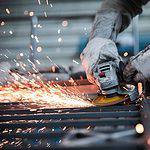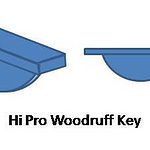Cam and follower is a type of assembly, both works together in any machine element. It is the example of higher pair due to the line contact between them. Some complicated motions are easily achieved by using cams and followers which are difficult to achieve. Cam is a mechanical element which is used to deliver the reciprocating or oscillating motion to another machine element known as follower. We can say that the cam and followers are the most important part of the mechanisms. The cams and follower combination is mostly used in internal combustion engines for operating inlet and exhaust valves, machine tools, printing control mechanism so on. They are generally manufactured by using die casting, milling and by punching.

Cam and Follower:
Types of followers:
Followers are classified in three main categories.
- According to the shape of the follower
- According to the motion of the follower
- According to the path of movement of follower
According to the shape of the follower:
The types of followers based on the shape of the followers are as follow
1. Knife edge follower:
As per its name knife edge follower has sharp knife edge which comes into contact with the cam. The motion is take place between the cam and the sharp knife edge. In this follower a considerable side thrust exists between the guide and the followers. It is simple in construction but the use of this follower is very limited because high wear and tear takes place at the point of contact.
2. Roller follower:
In roller follower the contact surface of cam and follower is in the shape of rollers and the rolling motion is takes place between the contacting surfaces so chances of wear are very less of we can say that negligible. Due to less wear this follower is widely used and the cylindrical roller is free to rotate about the pin joint. This follower has pure rolling motion at low speed but at higher speed skidding also occurs in it. In roller follower also the side thrust exists between the guide and the follower same as the knife edge follower. These types of follower are used where space is not any problem like in aircraft engines and in some oil and gas engines etc.
3. Spherical faced followers:
In these followers the contacting surface is spherical in shape. These are used to minimize the stress induced which is generally seen in case of flat face followers. In case of flat face followers high surface stresses are generated at high speed. So to minimize the all these stresses the flat face of the follower is changed into the spherical shape, due to this changed shape the very less stresses will induced in the follower and it can be used in high speed engines.
4. Mushroom or flat face followers:
As name suggest the contacting surface is as a shape of Mushroom (circular in shape) or flat. There is very less side thrust seen in this case as compare to the roller and knife edge follower which make it stable even at high speed and it does not cause any problem of jamming of cam. It this follower high surface stresses are induced due to the misalignment and deflection, this is the major drawback of this follower. These induced stresses are the reason of high wear. This follower is used in the valve opening mechanism of automobile engine where space available is limited.
According to the motion of the follower:
There are two types of followers according the motion these are
1. Reciprocating or translating followers:
In this type the motion of the follower is reciprocating or translating in the guides where as cam rotates uniformly.
2. Oscillating or rotating followers:
In this case the follower oscillates when the cam rotates. The follower is pivoted at a fix position where oscillating or rotating motion in the follower takes place.
According to the path of movement of follower:
According to the movement followers are two types these are as follow
1. Radial follower:
When the line of action of the motion of the follower is passes through the center of rotation of the cam then it is known as the radial follower.
2. Off-set followers:
when the line of action of motion of the follower is offset/ away from the center of rotation of the cam then it is known as off-set followers.
Types of cams:
We use different types of cams in various applications. Some of the commonly used cams are as follows.
1. Wedge or flat cam:
Wedge cam has a wedge which moves in translation motion but the follower on it can either oscillates or translates. Spring is used to maintain the contact between the cam and the followers. Sometimes flat plate is also used at the place of wedge with grove in which follower is held and rotates, in this grove a roller follower is used.
2. Radial or disc cam:
As per its name in radial cam the follower movement is takes place radially in the center of the cam. Cam is pin join and the follower rotates in radial motion with respect to the cam. This cam is very compact and simple in working.
3. Cylindrical cam:
In cylindrical cam a cylindrical circle is rotates about its own axis. It is also known as barrel cam. The follower is attached with the spring comes into the contact of cylindrical cam in two ways i.e. in first case a groove is cut on the periphery of the barrel and the follower is constrained into this grove where it is oscillating. In second case the end of the cylinder is work as working surface.
4. Spiral cam:
Spiral cam is used in the application of computers where we need to reverse the direction of cam by resetting the position of the follower this can be done with the grooves cut in the form of spiral on the face of the cam. These spiral type grooves have teeth which come into the contact with a pin gear follower. The movement of the follower is depends upon the radial distance of the grooves which is measure from the axis of the cam.
5. Globoidal cam:
It has two types one is concave surface and other is convex surface type. A circumferential cut is made on the periphery of the cam for the rotation of the follower. The working of both convex and concave type’s surfaces is same but applications are different. The follower has oscillating motion. This type of cams is used in medium speed engine where follower has to move in a large angle of oscillation.
6. Conjugate cam:
Conjugate cam is combination of two discs. These two discs are perfectly joined together and come in contact with the follower. Here two roller followers are used which constrain opposite to each other. The main advantage of this type of follower is they work noise free and the wear tear rate is very less as compare to other cams. For high speed and high dynamic load applications this cam is best among all.

These are all main types types of cam and followers. If you have any query regarding this article, ask by commenting. If you like this article, don’t forget to share it on social networks. Subscribe our website for more informative article. Subscribe our website for more informative article. Thanks for reading it.








Very helpful website for all Mechanical students. Thanks and keep adding more and more concepts.